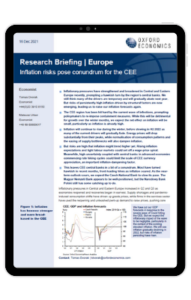Inflation risks pose conundrum for the CEE

Inflationary pressures have strengthened and broadened in Central and Eastern Europe recently, prompting a hawkish turn by the region’s central banks. We still think many of the drivers are temporary and will gradually abate next year. But risks of persistently high inflation driven by structural factors are now emerging, leading us to raise our inflation forecasts again.
What you will learn:
- The CEE region has been hit hard by the current wave of infections, prompting policymakers to re-impose containment measures.
- Inflation will continue to rise during the winter, before slowing in H2 2022 as many of the current drivers will gradually fade.
- But risks are high that inflation might trend higher yet. This leaves CEE central banks in a bit of a conundrum. Most have turned hawkish in recent months, front-loading hikes as inflation soared.
Tags:
Related research

Post
UK: Supply constraints are probably less prominent in the south
The extent to which UK employers can respond to likely 2024 interest rate cuts with increased output, rather than rises in prices and wages, will partly reflect the extent of spare capacity. This will inevitably vary by region. Evidence on this is imperfect, but in terms of capital assets (including intangibles) and labour availability, southern regions appear to be in a stronger position than those in the UK's traditional industrial heartland.
Find Out More
Post
Global Private equity real estate fund maturities spur asset sales
We expect the significant increases in fund maturities, spurred by capital raised over the past decade, to exert upward pressure on the rate of asset disposals as the funds approach the end of their lifecycles.
Find Out More